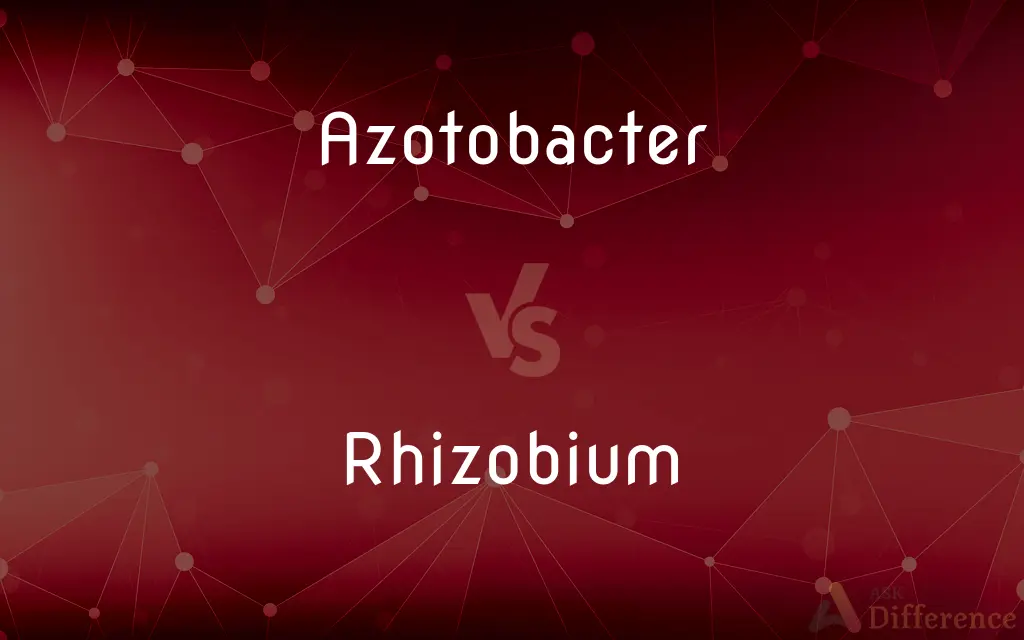Azotobacter vs. Rhizobium — What's the Difference?
By Tayyaba Rehman & Urooj Arif — Updated on March 20, 2024
Azotobacter are free-living, nitrogen-fixing bacteria found in soil, which do not require a plant host for nitrogen fixation. Rhizobium, however, forms symbiotic relationships with legumes to fix nitrogen, residing in root nodules of the host plant.

Difference Between Azotobacter and Rhizobium
Table of Contents
ADVERTISEMENT
Key Differences
Azotobacter species are known for their ability to fix atmospheric nitrogen into a form usable by plants, while independently living in the soil. On the other hand, Rhizobium species engage in a symbiotic relationship with leguminous plants. They infect the roots of these plants, leading to the formation of root nodules where nitrogen fixation occurs.
Azotobacter can be found in various soil types, often in those rich in organic matter, and they contribute to the nitrogen content without specific plant partners. Rhizobium, in contrast, specifically targets leguminous plants, with different Rhizobium strains having particular host plant preferences.
The role of Azotobacter in agriculture and ecology is primarily as a soil inoculant to increase nitrogen levels, thereby promoting plant growth indirectly. Rhizobium, however, is used directly in legume crop cultivation, such as peas, beans, and clover, to enhance nitrogen fixation directly to the benefit of the crop, reducing the need for chemical nitrogen fertilizers.
While both genera play crucial roles in nitrogen fixation, their mechanisms of action, relationships with plants, and applications in agriculture differ markedly. Azotobacter's free-living lifestyle allows them to benefit a broader range of plants indirectly, whereas Rhizobium's symbiotic relationships target specific leguminous species, providing direct nutritional benefits. Understanding these differences is essential for managing soil fertility and optimizing crop production strategies in sustainable agriculture.
The specificity of Rhizobium to legumes versus the generalist approach of Azotobacter highlights the diversity of strategies bacteria use to interact with their environment and host organisms. This specificity also reflects in agricultural practices, where the choice between using Azotobacter- or Rhizobium-based biofertilizers depends on the type of crops being cultivated.
ADVERTISEMENT
Comparison Chart
Nitrogen Fixation
Free-living, fixes nitrogen independently
Forms symbiosis with legumes for nitrogen fixation
Habitat
Non-specific soil environments
Root nodules of leguminous plants
Relationship with Plants
Indirect benefit to plants
Direct, symbiotic relationship
Agricultural Use
Used as biofertilizer for a wide range of crops
Used specifically for leguminous crops like beans and peas
Survival Mechanism
Forms cysts to survive harsh conditions
Depends on host plant for survival
Compare with Definitions
Azotobacter
Known for their role in the nitrogen cycle.
By fixing atmospheric nitrogen, Azotobacter species contribute to soil fertility.
Rhizobium
Specific to leguminous host plants.
Different Rhizobium strains are specialized for symbiosis with specific legume species.
Azotobacter
Can survive in various soil types.
Azotobacter can be found in both arid and fertile soils, adapting through cyst formation.
Rhizobium
Crucial for sustainable agriculture.
Using Rhizobium inoculants in legume cultivation reduces the need for synthetic nitrogen fertilizers.
Azotobacter
Used in agriculture to support plant growth.
Azotobacter biofertilizers are applied to cereal crops to reduce nitrogen fertilizer needs.
Rhizobium
Lives in root nodules of legumes.
Rhizobium bacteria reside within nodules formed on the roots of their leguminous hosts, where they fix nitrogen.
Azotobacter
A genus of free-living nitrogen-fixing bacteria.
Azotobacter chroococcum is commonly used in biofertilizers to enhance soil nitrogen content.
Rhizobium
A genus of bacteria that forms symbiotic relationships with legumes.
Rhizobium leguminosarum forms nodules on pea plant roots for nitrogen fixation.
Azotobacter
Independently benefits soil and plant health.
Azotobacter activity enriches soil, indirectly supporting a wide range of plant species.
Rhizobium
Fixes nitrogen directly for plant use.
Rhizobium transforms atmospheric nitrogen into ammonia, directly utilized by leguminous plants.
Azotobacter
Azotobacter is a genus of usually motile, oval or spherical bacteria that form thick-walled cysts ( and also has hard crust )and may produce large quantities of capsular slime. They are aerobic, free-living soil microbes that play an important role in the nitrogen cycle in nature, binding atmospheric nitrogen, which is inaccessible to plants, and releasing it in the form of ammonium ions into the soil (nitrogen fixation).
Rhizobium
Rhizobium is a genus of Gram-negative soil bacteria that fix nitrogen. Rhizobium species form an endosymbiotic nitrogen-fixing association with roots of (primarily) legumes and other flowering plants.
Azotobacter
Any of various rod-shaped, aerobic, nitrogen-fixing bacteria of the genus Azotobacter, typically found in soil and water.
Rhizobium
Any of various aerobic bacteria of the genus Rhizobium that form root nodules in leguminous plants, such as clover and beans, where they establish a symbiotic relationship in which the bacteria obtain carbon and energy from the plant while supplying the plant with nitrogen by nitrogen fixation.
Rhizobium
(biology) Any of various bacteria, of the genus Rhizobium, that form nodules on the roots of legumes and fix nitrogen.
Rhizobium
Any diazotrophic bacterium that can fix nitrogen and form root nodules in legumes.
Rhizobium
The type genus of Rhizobiaceae; usually occur in the root nodules of legumes; can fix atmospheric oxygen
Common Curiosities
Why are Azotobacter and Rhizobium used in biofertilizers?
They naturally increase soil nitrogen levels, reducing the need for chemical fertilizers, and promoting sustainable agricultural practices.
What makes Azotobacter adaptable to various environmental conditions?
Azotobacter species form protective cysts that enable them to survive in harsh conditions, such as drought or nutrient-poor soils.
Can Rhizobium benefit non-leguminous plants?
Indirectly, by increasing the overall nitrogen content in the soil through their symbiosis with legumes, which can benefit subsequent non-leguminous crops in crop rotation systems.
How do plants benefit from Rhizobium?
Leguminous plants receive a direct supply of ammonia, a usable form of nitrogen, from Rhizobium, which is essential for their growth.
Can the use of Azotobacter and Rhizobium reduce environmental impact?
Yes, by decreasing reliance on synthetic nitrogen fertilizers, their use can reduce energy consumption and pollution associated with fertilizer production and application.
How does the symbiosis between Rhizobium and legumes occur?
It begins with complex chemical signaling between the bacteria and plant roots, leading to infection and the formation of nodules, where nitrogen fixation takes place.
How do Azotobacter and Rhizobium contribute to soil fertility?
Azotobacter enriches soil nitrogen content indirectly by fixing atmospheric nitrogen, while Rhizobium directly supplies leguminous plants with fixed nitrogen, reducing the plants' dependency on soil nitrogen.
What role do Azotobacter and Rhizobium play in nitrogen cycling?
Both play crucial roles in converting atmospheric nitrogen into forms usable by plants, thus facilitating the nitrogen cycle and enhancing soil fertility.
Are there any risks associated with using Azotobacter and Rhizobium as biofertilizers?
Generally considered safe and eco-friendly, there are minimal risks. However, incorrect application or use of contaminated products could potentially harm plant growth.
What future developments can be expected in the use of Azotobacter and Rhizobium for agricultural purposes?
Advances in biotechnology and microbiology may lead to the development of more efficient strains with enhanced nitrogen-fixing capabilities or specific adaptations to various environmental stresses, further promoting sustainable agriculture.
Is it possible to use both Azotobacter and Rhizobium in the same field?
Yes, in fields where leguminous and non-leguminous crops are grown together or in rotation, both types of biofertilizers can be beneficial.
How do environmental conditions affect the efficacy of Azotobacter and Rhizobium?
Their efficacy can be influenced by soil pH, moisture, temperature, and organic matter content, which affect bacterial survival, growth, and nitrogen-fixing activity.
How does the introduction of Azotobacter and Rhizobium affect the microbial diversity of soil?
Introducing these bacteria can enhance microbial diversity by adding to the natural populations of soil microbes, potentially improving soil health and ecosystem functions.
Can Azotobacter and Rhizobium coexist in the same soil environment?
Yes, they can coexist as they occupy different niches; Azotobacter lives freely in the soil, while Rhizobium forms symbiotic relationships with legume roots.
Share Your Discovery

Previous Comparison
Seashell vs. Conch
Next Comparison
Protection vs. GuidanceAuthor Spotlight
Written by
Tayyaba RehmanTayyaba Rehman is a distinguished writer, currently serving as a primary contributor to askdifference.com. As a researcher in semantics and etymology, Tayyaba's passion for the complexity of languages and their distinctions has found a perfect home on the platform. Tayyaba delves into the intricacies of language, distinguishing between commonly confused words and phrases, thereby providing clarity for readers worldwide.
Co-written by
Urooj ArifUrooj is a skilled content writer at Ask Difference, known for her exceptional ability to simplify complex topics into engaging and informative content. With a passion for research and a flair for clear, concise writing, she consistently delivers articles that resonate with our diverse audience.
















































